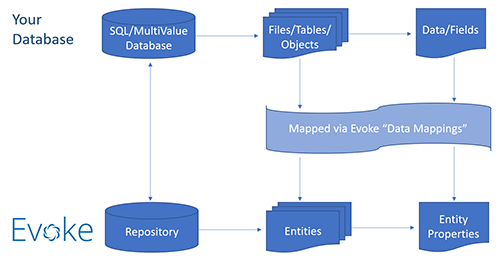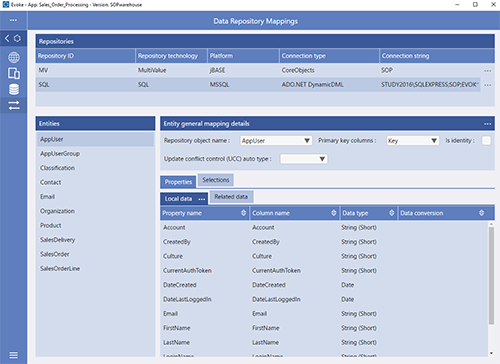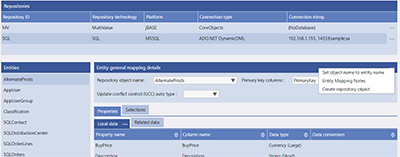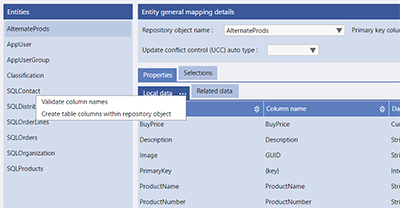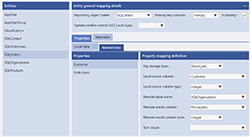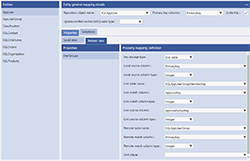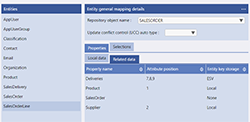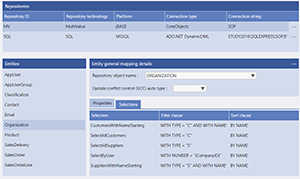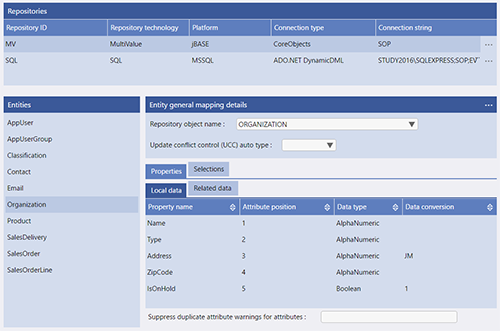Entity General Mapping Details
Optionally for each Entity you can set the Update Conflict Control (UCC) Auto Type. Update Conflict Control refers to the process of managing situations where more than one user modifies the data associated with the same entity instance at the same time.
For SQL databases there are two further options that should be set:
-
Primary Key Columns - Select, from the dropdown list, the Primary Key Column of the repository table.
-
Is Identity (Checkbox) - identifies if the Primary key column is also an identity (auto increment) column that will be automatically incremented, by the database, when Evoke saves a new record to the database.
For all database types there is an ellipsis menu on the Header of the "Entity General Mapping Details" that offers the following additional options for each Entity that is selected in the panel on the left:
-
Set Object Name to Entity Name - This simply sets the name in the "Repository Object Name" box to be the same as the Entity. It is included purely for convenience and saves typing the name if it is planned to be the same and does not yet exist.
-
Entity Mapping Notes - Opens a free format notes area, attached to each Entity in the Data Mappings area, that allows you to add some free format notes to describe the mappings you are creating, allowing you to refer back to these notes at a later time.
-
Create Repository Object - (Currently SQL Databases only) - Creates a new Table in your Repository (your database) using the "Repository Object Name" . This option is part of the exporting of Entity structures to your database.
Properties
-
Validate Column Names - Completes a check that the Column names you have specified in these data mappings are actually in your database (repository) table and are spelled correctly.
-
Create Table Columns within Repository Object - Creates the columns relating to this Entity within your Table in your Repository (database). This option is part of the exporting of Entity structures to your database.
For all database types against each Property of Local data (properties held locally in this table/file) you can define:
-
Column Name (SQL) or Attribute Position (MultiValue DB) - if a property is not represented in the database then its column name or attribute position can be left blank. For SQL tables if the key is defined as a property as well as the Primary Key then the property column should be set to {key}. For MultiValue files if the item ID is represented by a property then this should be set to attribute position 0.
-
Data Type of the property/column (field) in your Repository (database) - this should relate to the data type that you have defined in your Entity for the Property and are shown in the dropdown list of options.
For MultiValue Databases these include: Alphanumeric, Integer, Boolean, Currency, Decimal, Date, Time
For SQL Databases these include: String, Integer, Boolean, Currency, Decimal, Data, Time, DateTime -
Data Conversion - some properties e.g. decimals and currency benefit from having a conversion option to set the number of decimal places in the value i.e. to two places, etc. Boolean values can also be converted to have a value of 1 or "Y" or other as the true or false value. There is a "Build" button that will guide you through the properties that can be converted and what the conversion options are.
Against each Property of Related data (properties holding a key or link to a record or multiple records in another table/file) you need to define different options for SQL databases and MultiValue Databases:
-
Direct Join - Used to create a 1 to many or 1 to 1 relationship between records in different tables. An example of a Direct Join is shown on the right, click on the image to make it bigger.
The entries are to identify the column name and data type in the current table that will be matched with columns in a different table or the current table. -
Custom - Used to create an Evoke code hook in the Visual Studio Repository code where custom code can be placed to effect a join between columns in multiple tables.
-
Link Table - Used to create a many to many relationship between records in different tables. An example of Link Table options is shown on the right, click on the image to make it bigger.
The entries are similar to a direct join except there is an interim, independent table that has the join values.
-
Local - the key(s) to the related record(s) is held in this field. An example of "Local" Related Data options is shown on the right, click on the image to make it bigger.
-
LocalSV - the key(s) to the related record(s) are held in this field as a local sub-valued list.
-
Remote - the key(s), 'linking' to this record, is held in the related entity (requires small modification to the CRUD to select out the related items of the related entity, there is an example of this in the generated CRUD .custom files).
-
EMV - Embedded MultiValues - Used when the related entity (record) is represented by one or more multivalued attributes. Need to supply a comma separated list of those attributes e.g. 7,9,10,13,14 etc.
If the related entity is a series of multivalued data e.g. the lines of an address, etc. then Evoke will need to represent this as a related Entity (with properties e.g. address line1, address line2, etc.) and the multivalued data mapped as sub-attributes e.g. 9.1, 9.2, 9.3, etc -
ESV - Embedded SubValues - Used when the related entity is represented by one or more subvalued multivalues. Need to supply a comma separated list of those multivalue positions. An example of Embedded SubValues options is shown on the right, click on the image to make it bigger.
-
Custom - Custom CRUD code will handle the retrieval of related data. Used in instances where the key may need to be manipulated further prior to retrieval of the related entities.
-
None - No key storage is required
Please also see the section on Related Entities for additional information and the specific guidence on AppUser/AppUserGroups associations for examples.
- Custom implementation UCC is either not required for this Entity type or is custom implemented. This way requires you to write a small section of code in the middle tier (C#) that handles the decision as to whether an update conflict has occurred and what to do (accept, reject or merge) if it has.
- Timestamp UCC is automatically operated for this Entity type using a timestamp value. This approach allows a column/attribute within the repository table/file to be used to hold a date/time modified timestamp that is used to automatically control update conflict.
- GUID UCC is automatically operated for this Entity type using a GUID value. This approach allows a column/attribute within the repository table/file to be used to hold a GUID (Globally Unique IDentifier) value that is used to automatically control update conflict.

